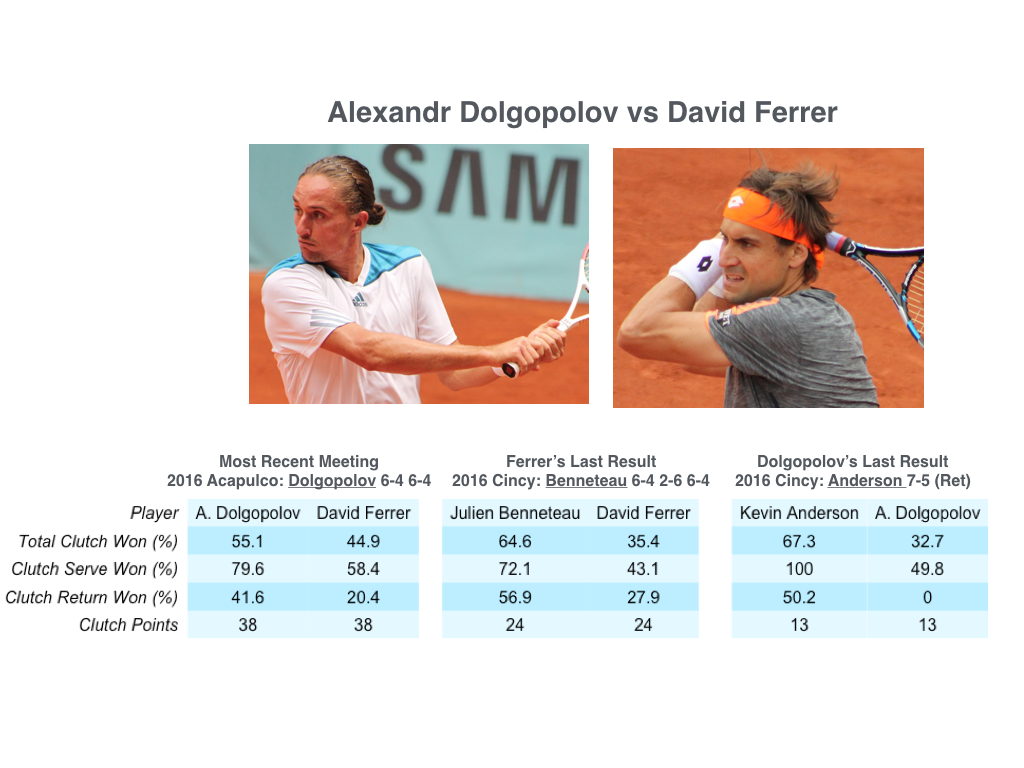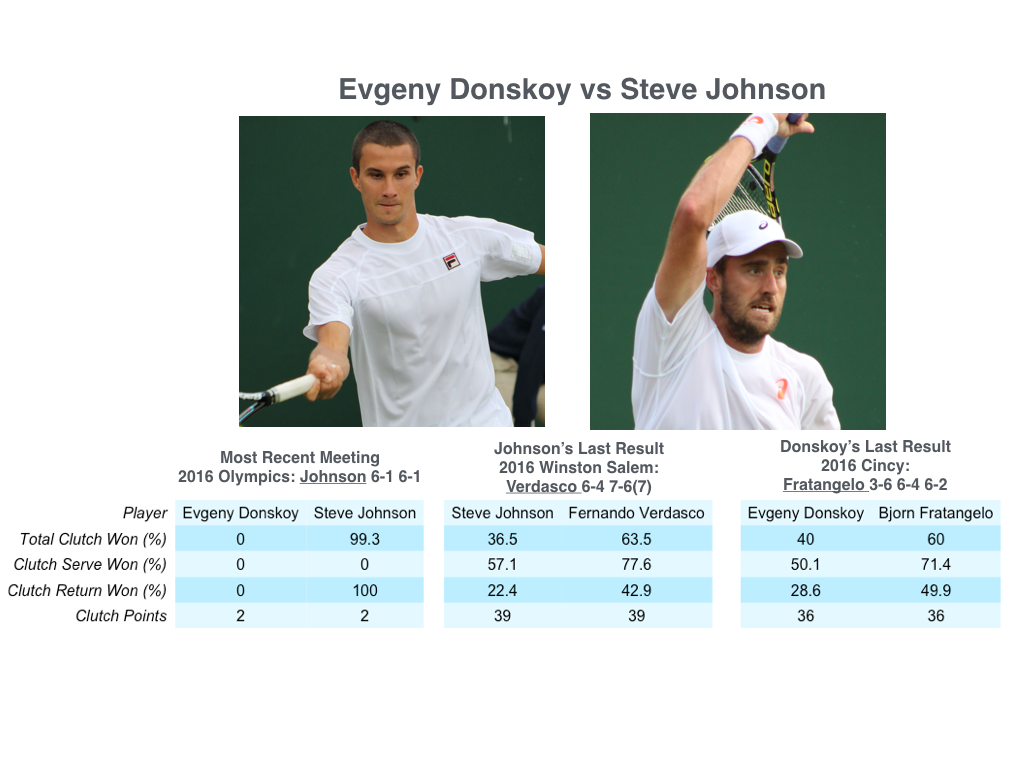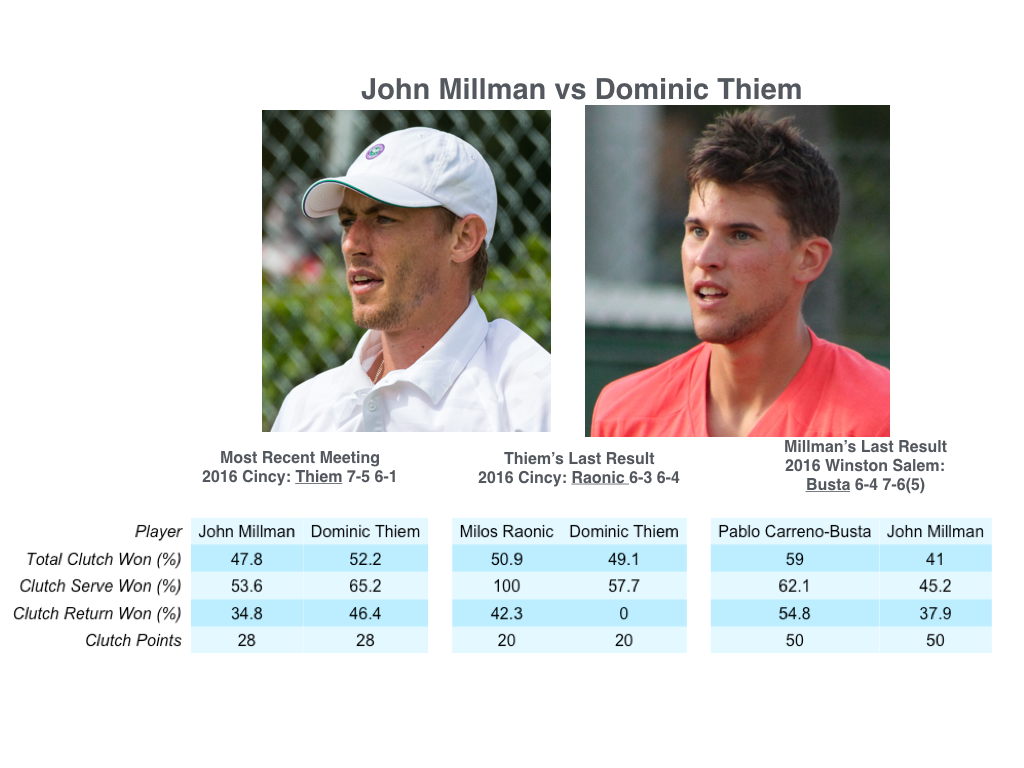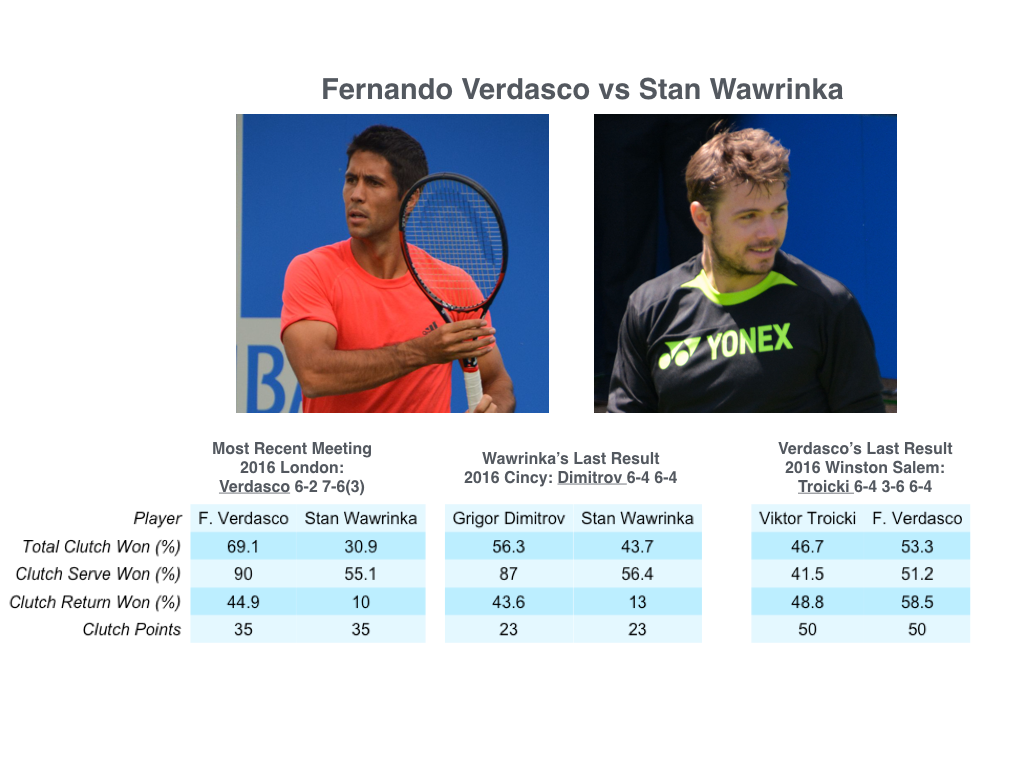US Open Men's First Round Clutch Preview
The first round of the main draw of the 2016 US Open begins today. If you are like me you have spent a good part of the weekend digesting the draw and making predictions about which matches could be the most interesting to come out of Flushing Meadows. In this post, I want to highlight a few of the matches that stood out to me. In doing so, I also want to introduce a new way of looking at recent form with something I call clutch averaging.
When mulling over a draw, it is typical to look back at the stats from recent matches and head-to-heads. The stats that are most commonly reported are simple averages of serve and return events. These do a good job of telling us about a player’s overall form. But they fail to tell us how a player has been handling pressure, which is often the more critical question to winning. This is where “clutch averaging” comes in.
The basic idea behind clutch averaging is to put more emphasis on the points that have the most importance to the match outcome and, we would expect, exert more pressure on the player than less important points. These are points that hone in on a player’s clutch ability. We can put more emphasis on important points by weighting points by their importance.
Importance isn’t just a word we use in tennis. It is actually something we can put a number to. Thanks to Harvard statistician Carl Morris, we have a mathematical formula to calculate the importance of every point in tennis. The formula is a player’s expected chance of winning a match when the current point is won versus when it is lost. By this standard, a break point in set-deciding game will have high importance while the first point of match will generally have low importance.
The actual weights I apply are the point importance for the average tour player (using a different average for men and women). Since I have found that discounting some points of low importance actually improves the performance of the clutch-averaged statistics, in terms of their ability to differentiate winners from losers, points of less than 5% importance for men and 6% importance for women are set to zero.
To illustrate how the average is actually calculated, suppose that the state of interest is the proportion of clutch server points won. Using $S_i$ as a zero-one indicator of a win on the $i$th service point and $W_i$ the importance weight for the $i$th point, this stat is calculated as follows:
$$ \mbox{Clutch Serve} = \sum_i (S_i \times W_i) / \sum_i W_i. $$
In contrast to the percent of service points won, the clutch-averaged stat tells us the percent of important service points won. And the same idea can be applied to any event of interest: clutch aces, clutch first serves in, clutch winners, etc.
As a preview for the men’s first round, I have gathered clutch reports on total, serve, and return points won for a selected set of matches. In each report, I include the summary for the last meeting of the two who were drawn to play in the first round and of each player’s most recent match (whoever the opponent). The matches that are included are ones with opponents who have played in the past and that, for various reasons, are noteworthy.
Match Previews
It’s been a disappointing year for Dolgopolov and Ferrer, whose rankings have both dropped over the season. Although neither is playing at their peak, this could make for a more interesting first round match. Elo predictions give Ferrer a 73% chance of winning the match. However, Dolgopolov upset Ferrer at their last meeting during the clay court swing, winning 55% of clutch points. Dolgopolov handled pressure on serve particularly well when these players last met, winning 80% of the most important service points. Similar form in New York could make this one of the closer matches in the early rounds. Both players enter the tournament coming off tough losses to bigger servers.

Evgeny Donskoy and Steve Johnson should be very familiar with each other’s games when they met at the US Open, as they played each other in Rio just a few weeks ago. That much was all-Johnson, as we can see from the small number of clutch points the match produced. Johnson’s dominance in that match made it a low-pressure affair. Johnson’s has been on something of a roll this year and goes into this match with an 83% win expectation. We might expect those chances to get a boost by the home crowd. If they do, this could be a quick much but still an interesting one to get an early peak at the form of one the American hopefuls.

After facing off recently at Cincy, John Millman will get his rematch against Dominic Thiem sooner than he expected. The tight first set they played in Ohio made this a very even match in terms of clutch points won, Thiem having the edge with 53%. If Millman wants to change the tables this time around he will have to handle the pressure on the return better than in their last meeting. Both players have struggled on the return side of the game in their last matches, which could make this a closer match than rankings would suggest.

There are two all-American first round matches: Taylor Fritz versus Jack Sock and Frances Tiafoe versus John Isner. Fritz and Sock’s last meeting was a very close five-setter at the first Grand Slam of the year. Sock had a strong edge on the important points in that match. That result would seem to give Fritz a steep upward battle, but his performance against Fernando Verdasco in Winston Salem last week, where he kept the match nearly even on important serve and return points, bodes for a possible upset.

Verdasco’s first match will also be one worth watching. He will face Stan Wawrinka, the third seed in this year’s draw. With the bumpy season Wawrinka has had, including a loss to Verdasco in London where he managed to win just 30% of important points, it is anyone’s guess who will emerge the winner from this match. Both players are coming off close losses in their warm-up tournaments. Verdasco’s loss had to be the particularly frustrating one as he actually had edged out Troicki on important points won but still managed to lose. I think we can expect an especially determined Verdasco at Flusing, as no player will want to experience that kind of defeat back-to-back.


